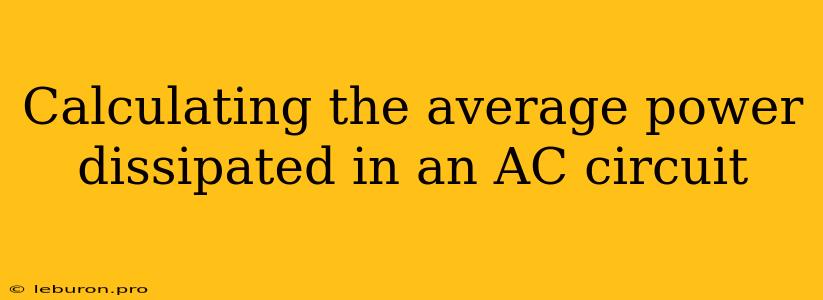Understanding how to calculate the average power dissipated in an AC circuit is crucial for analyzing and designing electrical systems. Unlike DC circuits where power is simply the product of voltage and current, AC circuits exhibit a phase difference between voltage and current, leading to a more complex power calculation. This article will explore the concepts of average power, power factor, and the methods for determining the average power dissipated in various AC circuit configurations.
Understanding Power in AC Circuits
In an AC circuit, the voltage and current waveforms are sinusoidal, varying with time. This sinusoidal nature introduces a concept called power factor, which represents the phase difference between voltage and current.
Power Factor (PF) is a measure of how effectively electrical power is being used in an AC circuit. It is the cosine of the angle between the voltage and current waveforms.
- PF = 1: Indicates the voltage and current are in phase, meaning all the power delivered is being used.
- PF < 1: Indicates a phase difference between voltage and current, leading to some power being wasted.
Calculating Average Power
The average power dissipated in an AC circuit represents the average rate at which energy is consumed over a complete cycle of the AC waveform. It can be calculated using several methods:
1. Using RMS Values
The most common method uses the root-mean-square (RMS) values of voltage and current:
Average Power (P) = Vrms x Irms x PF
- Vrms: The RMS voltage of the AC circuit.
- Irms: The RMS current of the AC circuit.
- PF: The power factor of the circuit.
2. Using Instantaneous Power
Average power can also be calculated by averaging the instantaneous power over a complete cycle. The instantaneous power is the product of instantaneous voltage and current:
P(t) = V(t) x I(t)
To find the average power, we integrate the instantaneous power over one complete cycle and divide by the period:
Average Power (P) = (1/T) ∫[0 to T] P(t) dt
3. Using Impedance and Current
For circuits with a single impedance (Z), we can express the average power in terms of impedance and current:
Average Power (P) = Irms^2 x R
- R: The resistive component of the impedance.
Example Calculation
Let's consider a series RLC circuit with a voltage source of 120 Vrms, a frequency of 60 Hz, a resistance of 10 ohms, an inductance of 0.1 H, and a capacitance of 100 µF.
1. Calculate the impedance:
- Z = √(R^2 + (XL - XC)^2)
- XL = 2πfL = 2π(60)(0.1) = 37.7 ohms
- XC = 1/(2πfC) = 1/(2π(60)(100 x 10^-6)) = 26.5 ohms
- Z = √(10^2 + (37.7 - 26.5)^2) = 15.6 ohms
2. Calculate the current:
- Irms = Vrms / Z = 120 / 15.6 = 7.7 A
3. Calculate the power factor:
- PF = R / Z = 10 / 15.6 = 0.64
4. Calculate the average power:
- P = Vrms x Irms x PF = 120 x 7.7 x 0.64 = 590 W
Therefore, the average power dissipated in the series RLC circuit is 590 W.
Importance of Calculating Average Power
Calculating the average power dissipated in an AC circuit is crucial for several reasons:
- Power Consumption: It helps determine the actual energy consumption of the circuit, allowing for accurate billing and efficiency analysis.
- Component Selection: Knowing the power dissipated helps select appropriate components like resistors, capacitors, and inductors that can handle the expected power levels.
- Circuit Design: The power calculation aids in designing and optimizing AC circuits for maximum efficiency and minimizing energy loss.
- Thermal Management: Understanding power dissipation is essential for managing heat generation within electrical systems to prevent overheating and component failure.
Conclusion
Calculating the average power dissipated in an AC circuit is essential for analyzing, designing, and operating electrical systems effectively. By understanding the concepts of power factor, RMS values, and the various methods for calculating average power, engineers and technicians can ensure efficient and reliable operation of AC circuits. From determining energy consumption to selecting appropriate components, the ability to calculate average power dissipated plays a critical role in achieving optimal performance and safety in AC applications.
